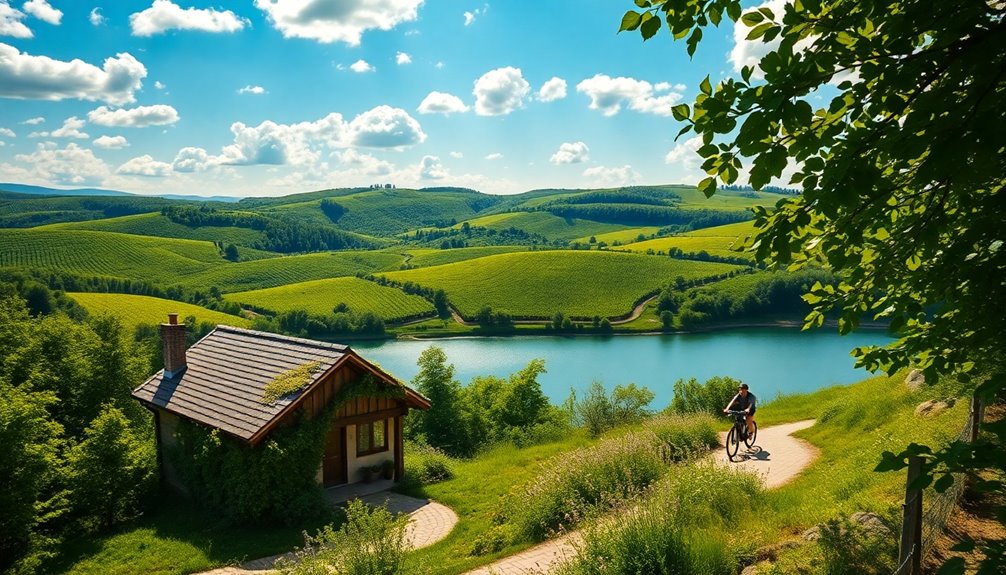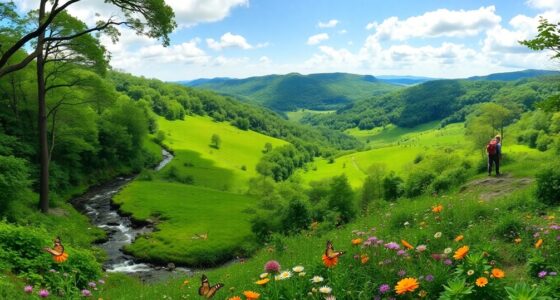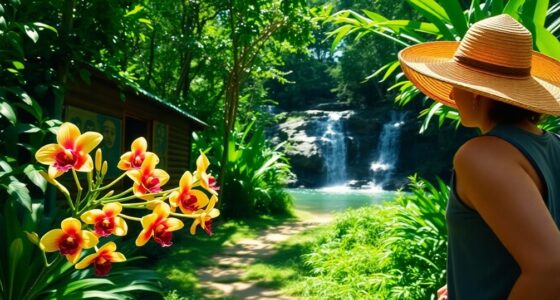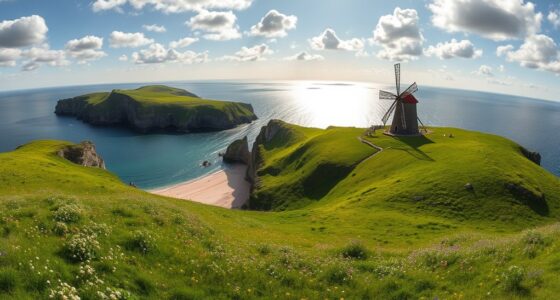Sustainable Hungary invites you to explore breathtaking green escapes in the heart of Europe. You can wander through its ten national parks, perfect for nature lovers and eco-tourism enthusiasts alike. The Tokaj region offers unique vineyard tours that celebrate local biodiversity while fostering sustainable practices. Using Budapest's efficient public transport, you can reduce your carbon footprint and discover vibrant communities committed to conservation. Participate in community-led reforestation projects and enjoy springtime blooms in stunning landscapes. As you plan your adventure, you'll uncover more eco-friendly options awaiting your discovery.
Key Takeaways
- Hungary's ten national parks and Natura 2000 network protect diverse ecosystems, offering eco-friendly recreational opportunities for sustainable tourism.
- The Tokaj region provides eco-friendly vineyard tours, cycling routes, and sustainable lodging, celebrating local biodiversity and winemaking traditions.
- Budapest's efficient public transportation, including electric buses and bike-sharing, supports eco-conscious travel and reduces carbon emissions.
- Community-led conservation initiatives and educational programs foster environmental stewardship and biodiversity restoration among locals and visitors.
- Eco-friendly travel in Hungary promotes healthier lifestyles, local culture appreciation, and supports conservation efforts aligned with global climate goals.
Introduction
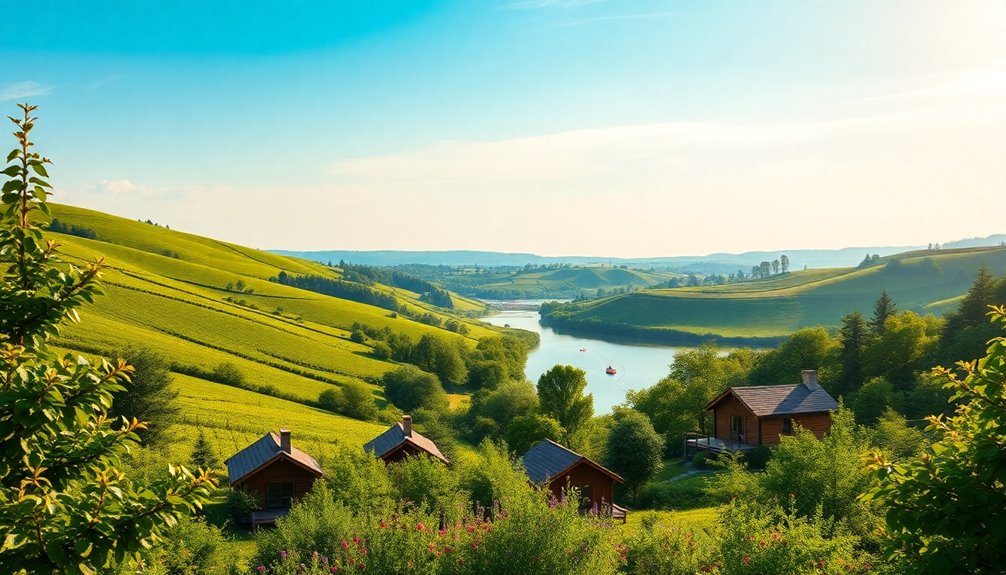
Hungary's rich biodiversity and stunning landscapes offer you a unique chance to explore nature while embracing eco-tourism. With its diverse ecosystems and cultural heritage, you can connect with the environment in meaningful ways. As you journey through this remarkable country, you'll discover how sustainable practices enhance both your travel experience and the preservation of its natural beauty. Many eco-friendly accommodations, such as eco lodges(#) and retreats, can be found throughout Hungary, promoting responsible tourism.
Rich Biodiversity and Landscapes
Nestled in the heart of Central Europe, Hungary boasts a stunning array of landscapes and rich biodiversity that captivates nature lovers and adventurers alike.
With ten national parks showcasing unique ecosystems, you'll discover countless recreational opportunities while immersing yourself in the country's natural beauty. The Natura 2000 network, covering 21% of Hungary, enhances conservation efforts, protecting vital habitats and species.
Kiskunság National Park, a UNESCO Biosphere Reserve, features salt lakes and sand dunes, hosting diverse wildlife that thrives in these environments. Additionally, Hungary's Ramsar wetlands are crucial for maintaining biodiversity and ecosystem services.
It's no wonder that Hungary's forests attract 40-50 million visitors annually, reflecting the growing interest in ecotourism and nature-based experiences.
Cultural Heritage Through Eco-Tourism
With its breathtaking landscapes and diverse ecosystems, Hungary offers more than just natural beauty; it also boasts a rich cultural heritage that thrives through eco-tourism.
Historical landmarks like the Chain Bridge and Matthias Church not only attract visitors but also promote environmentally friendly practices.
The Museum of Fine Arts in Budapest, a proud recipient of the EU Cultural Heritage Award, shows how entrance fees can aid in preserving cultural sites.
You can enjoy guided eco-friendly private tours that give you exclusive access to significant landmarks, ensuring your visit supports historical preservation.
Plus, culinary experiences featuring farm-to-table dining enhance your connection to local culture while celebrating sustainable tourism, making each experience memorable and impactful. Additionally, eco-tourism initiatives often reflect the importance of community and cooperation, fostering a deeper appreciation for both nature and cultural heritage.
Travel From New York City
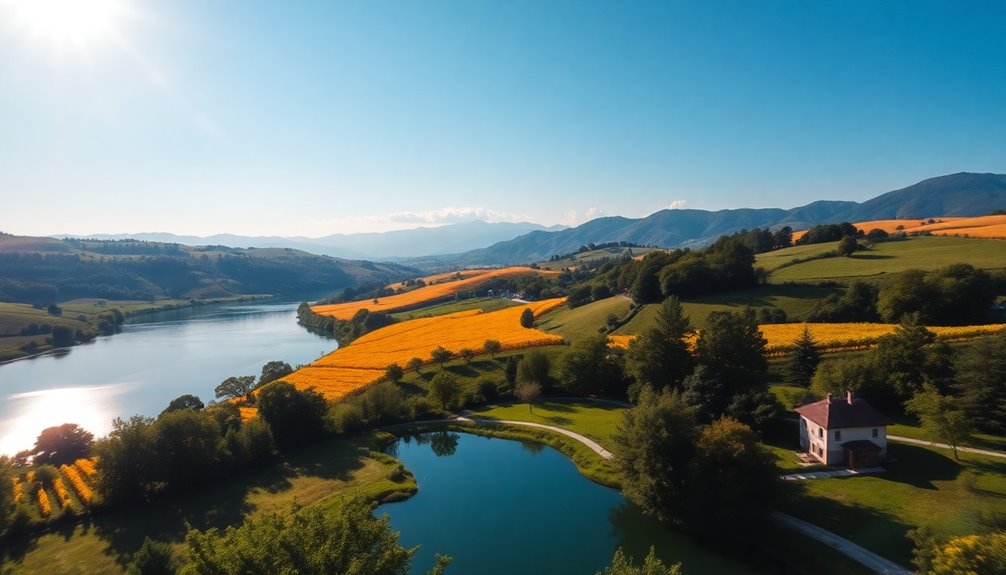
Traveling from New York City to Hungary is a breeze with direct flights to Budapest, making your eco-friendly vacation just a hop away.
Once you arrive, consider exploring the country's stunning landscapes and sustainable travel options, from hiking the National Blue Trail to enjoying farm-to-table dining.
Plus, with easy connections to Vienna, you can seamlessly incorporate more of Europe into your adventure.
Flights From USA to Hungary
How can you reach the enchanting landscapes of Hungary from New York City?
You'll find that direct flights typically take around 9-10 hours, with major airlines like Lufthansa, British Airways, and Air France offering convenient connections through European hubs.
Round-trip fares generally range from $600 to $1,200, depending on the season and how early you book.
To minimize your carbon footprint and greenhouse gas emissions, consider flying during the shoulder seasons of spring and fall, when fewer tourists visit and prices are better.
Once you land at Budapest Ferenc Liszt International Airport (BUD), you can explore local cuisine and duty-free shops.
Just remember to check visa requirements, as U.S. citizens can stay in Hungary for up to 90 days without one. Additionally, being mindful of your travel expenses can help you stick to your budget plan while enjoying your trip.
Travel From Vienna to Hungary
If you find yourself in Vienna, a quick train ride can whisk you away to Hungary in about 2.5 hours, offering a scenic and eco-friendly alternative to flying. This train journey not only minimizes your carbon footprint but also reveals the beautiful landscapes between the two countries.
Once in Hungary, dive into its eco-friendly tourism options, from exploring ten national parks to hiking the National Blue Trail, Europe's first long-distance route. Embrace the environmental commitment of Hungary, supported by government investments in sustainable tourism. Additionally, you can explore options for transportation that utilize hydrogen fuel cells, contributing to a cleaner environment.
Don't miss out on the farm-to-table culinary experiences, featuring locally sourced organic ingredients that enhance your travel while supporting local economies. This journey isn't just about travel; it's about making a positive impact.
Travel From Sydney to Hungary
Ever wondered how to make the long journey from Sydney to Hungary as enjoyable as possible? Start by planning your flights, as you'll likely face at least one layover in a major European hub. The total travel time usually ranges from 24 to 30 hours.
Once you arrive, immerse yourself in Hungary's eco-friendly tourism scene. With ten national parks, including Aggtelek and Hortobágy, you'll find breathtaking landscapes and diverse ecosystems.
Explore over 1.5 million steps of hiking trails, such as the National Blue Trail, and enjoy nature walks that have gained popularity post-COVID-19.
Seek out eco-friendly accommodations and tours that align with your desire for sustainable travel, ensuring a memorable and responsible adventure in Hungary!
Eco-Friendly Public Transit Options
When you're planning your trip from New York City to Hungary, consider the eco-friendly public transit options awaiting you in Budapest. The city boasts an efficient and affordable transport system that includes trams, buses, and metro lines, all designed with sustainability in mind.
- Electric buses and hybrid vehicles reduce carbon emissions.
- Seamless integration with bike-sharing services promotes active travel.
- Accessible national parks encourage sustainable tourism and nature conservation.
Budapest Transportation Company (BKK) actively supports environmental policy and fosters public awareness about the benefits of eco-friendly travel. Additionally, utilizing these public transit options can help lower your overall energy consumption during your trip, contributing to a more sustainable travel experience.
You can explore historical landmarks and beautiful parks while minimizing your carbon footprint, making your journey not just enjoyable but also responsible.
Embrace sustainable tourism and make a positive impact on the environment!
Sustainable Vineyard Tours in Tokaj
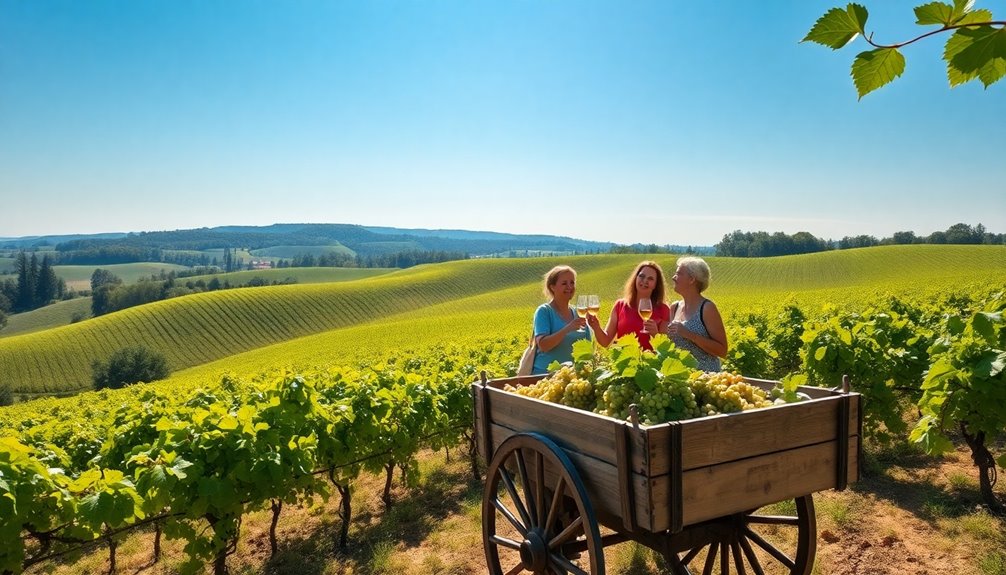
When you explore the vineyards of Tokaj, you'll discover eco-friendly tours that celebrate both the art of winemaking and the region's rich biodiversity.
These experiences often include cycling through picturesque landscapes, allowing you to appreciate the area's natural beauty while minimizing your carbon footprint.
Plus, you'll find sustainable lodgings crafted from local materials, making your stay as green as your adventures.
Eco-Friendly Wildlife Tours
As you explore the breathtaking Tokaj wine region, you'll discover a unique blend of eco-friendly practices and rich biodiversity that enhances your experience.
This UNESCO World Heritage site is perfect for those looking to connect with nature while enjoying world-class wines.
- Learn about organic farming techniques from passionate vineyard guides.
- Enjoy birdwatching and nature walks amidst stunning landscapes.
- Savor farm-to-table dining experiences featuring local ingredients.
These eco-friendly wildlife tours offer a deep dive into the region's commitment to sustainability.
You'll appreciate the importance of preserving local ecosystems while sampling Tokaji wines, like the renowned Tokaji Aszú. Additionally, understanding the role of support systems can enhance your experience as you connect with the local community.
Embrace the harmony of nature and agriculture in this enchanting corner of Hungary!
Eco-Friendly Cycling Tours
Exploring the Tokaj wine region on two wheels offers a thrilling way to experience its stunning landscapes and vibrant wine culture.
These eco-friendly cycling tours take you through picturesque vineyards, where you can savor organic wines made from indigenous grape varieties like Furmint and Hárslevelü.
As you pedal along the scenic routes, you'll connect charming villages while embracing sustainable tourism practices that minimize your carbon footprint.
Guided tours often highlight sustainable viticulture, teaching you about organic farming methods and the importance of preserving the local ecosystem.
Don't miss the chance to visit traditional wine cellars, where you'll learn about the history and craftsmanship of winemaking in an environmentally friendly way.
Enjoy an unforgettable adventure while supporting a greener future! Incorporating eco-friendly practices in your journey can further enhance your sustainability efforts.
Sustainable Lodgings With Local Materials
While you're discovering the beauty of the Tokaj region, consider staying in sustainable lodgings that utilize local materials. These accommodations not only enhance your experience but also reflect the rich cultural heritage of the area.
- Enjoy the unique ambiance created by locally sourced materials.
- Immerse yourself in eco-friendly practices that highlight traditional techniques.
- Learn about the region's biodiversity and conservation efforts during your stay.
Many vineyards in Tokaj offer these sustainable lodgings, allowing you to appreciate the exceptional quality of Tokaji wines, especially the renowned Aszú dessert wine.
Plus, by choosing these eco-conscious options, you support local initiatives and responsible tourism, ensuring a memorable and impactful visit to this stunning region. Additionally, you can experience traditional ceremonies that showcase the local culture and history during your stay.
Support Local Eco-Friendly Businesses
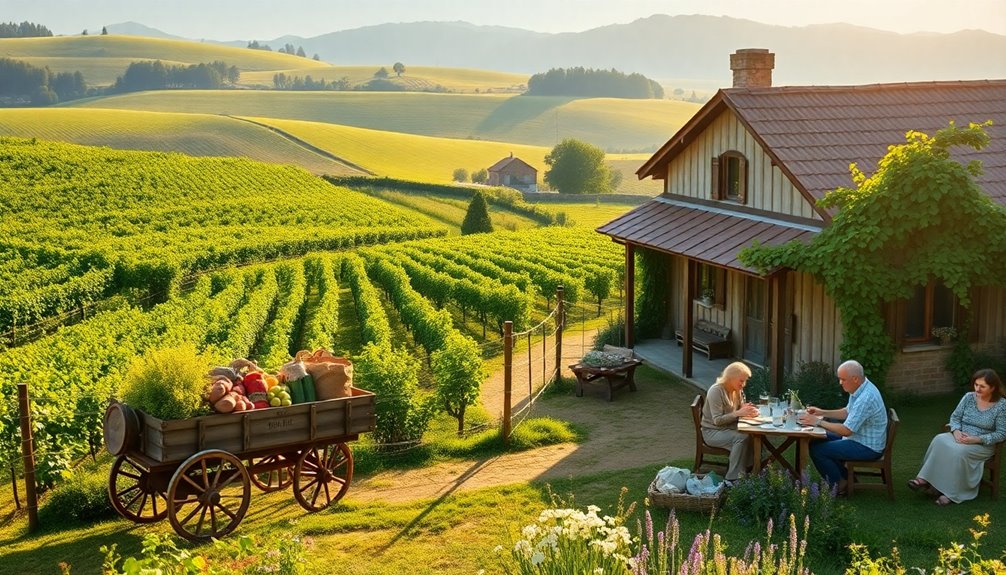
Supporting local eco-friendly businesses not only enriches your travel experience but also helps sustain Hungary's vibrant communities and natural landscapes. With 75% of travelers seeking eco-conscious options, you'll find a wealth of sustainable accommodations, tours, and culinary experiences that promote local practices. By choosing to support local businesses, you contribute to community initiatives and conservation efforts while indulging in Hungary's rich culture. Additionally, engaging in these practices fosters personal growth and encourages a deeper connection to the environment.
| Type of Business | Eco-Friendly Practices | Benefits to Locals |
|---|---|---|
| Eco-Lodges | Use local materials | Job creation and income |
| Organic Restaurants | Local ingredients | Supports local farmers |
| Guided Nature Tours | Low-impact exploration | Conservation awareness |
| Artisan Shops | Sustainable products | Cultural preservation |
Engaging with these businesses empowers the local economy and preserves Hungary's stunning environment.
Community-Led Reforestation Projects
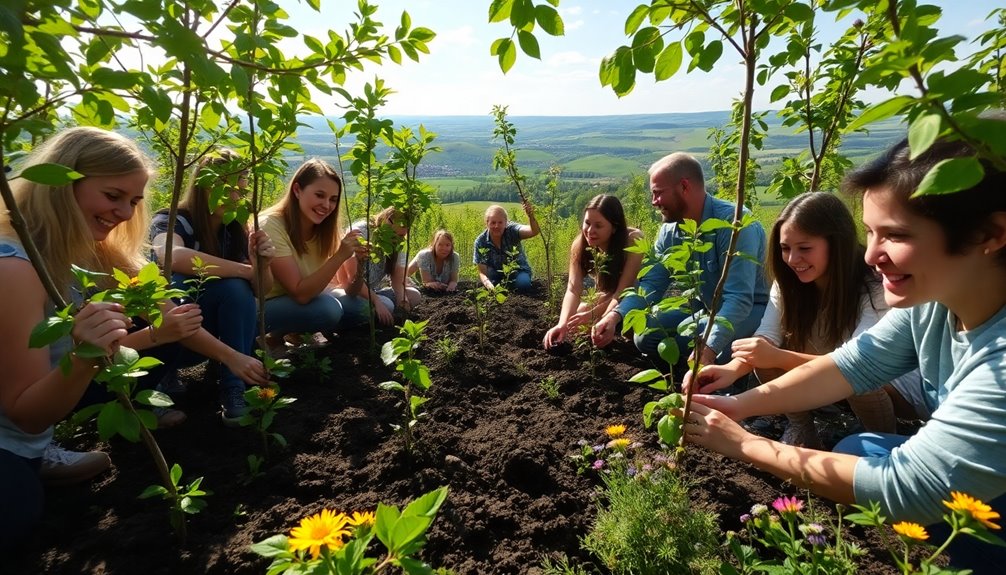
Community-led reforestation projects in Hungary are gaining traction, thanks to increased support from both the government and NGOs.
You can see how these initiatives not only restore biodiversity but also strengthen community ties and cultural sustainability.
Government and NGO Efforts
As Hungary strives to meet its climate neutrality goals by 2050, government and NGO efforts in community-led reforestation projects are making a significant impact.
These initiatives not only restore biodiversity but also enhance carbon sequestration, helping
Community and Cultural Sustainability
While many might think of reforestation solely as an environmental effort, it's also a vital way to strengthen community bonds and cultural identity.
In Hungary, community-led reforestation projects enhance local biodiversity while engaging residents in planting native tree species. These initiatives, supported by government investments, aim for sustainable economic growth and ecological awareness among young tourists.
Hungary's Natura 2000 network, covering 21% of the country, provides essential frameworks for conservation and restoration.
Collaborative efforts between NGOs, local governments, and communities have successfully planted thousands of trees, combating climate change and fostering local ecosystems.
Educational programs accompanying these projects raise awareness about the importance of forests, nurturing a culture of sustainability that binds communities together.
Spring for Blooming Landscapes
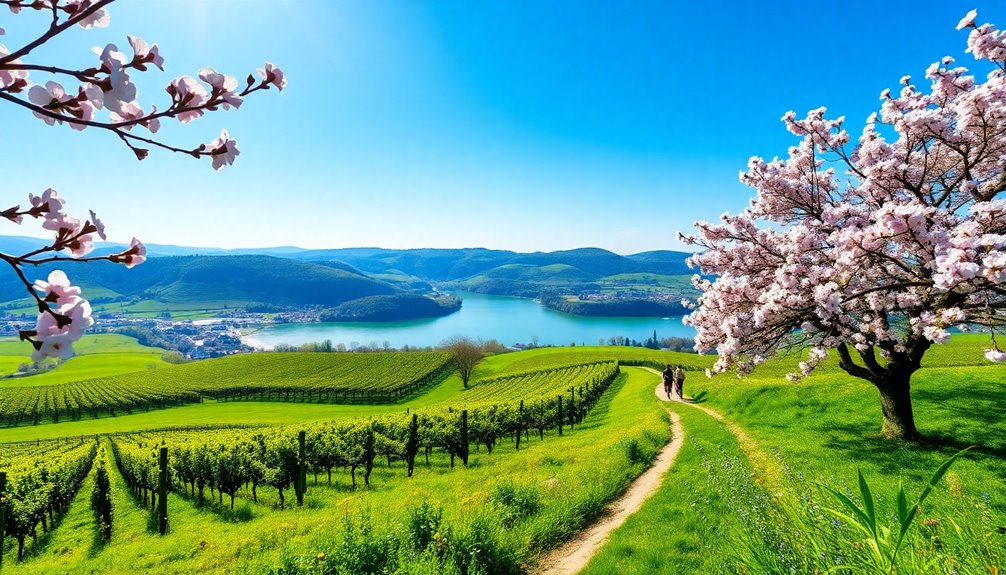
Spring in Hungary invites you to witness nature's vibrant awakening, transforming landscapes into a feast for the eyes.
As you breathe in the fresh air and take in the blooming flora, you'll notice how seasonal weather patterns can shape your travel plans.
Whether you're hiking along the National Blue Trail or enjoying local spring dishes, this season is perfect for exploring Hungary's rich ecosystems.
Autumn's Colorful Foliage Display
When you wander through Hungary's forests in autumn, you'll be captivated by a vibrant tapestry of colors that draws 40-50 million visitors each year.
The beauty of autumn's colorful foliage display transforms the landscape into stunning vistas, making it a perfect time for outdoor activities.
- Hike along the National Blue Trail (OKT) for breathtaking views.
- Enjoy birdwatching at Lake Balaton, where migratory birds contrast against brilliant leaves.
- Savor local culinary delights at harvest festivals amidst beautiful landscapes.
Embracing eco-friendly accommodations enhances your experience, allowing you to appreciate nature while minimizing your ecological footprint.
Seasonal Weather Patterns Impact Travel
As autumn fades, Hungary reveals a stunning transformation in its landscapes, inviting travelers to experience the vibrant bloom of spring.
Seasonal weather patterns bring mild temperatures, making it the perfect time for nature walks in national parks like Aggtelek and Hortobágy. Here, you can witness the positive change as flora bursts into life and local wildlife emerges from hibernation.
With the Hungarian government promoting eco-friendly tourism, you'll find a growing selection of sustainable accommodations and tours.
Plus, culinary festivals celebrating farm-to-table dining showcase fresh, seasonal produce, enhancing your travel experience. Additionally, many of these accommodations are incorporating renewable energy sources to reduce their environmental impact and promote sustainability.
Embrace the beauty of Central Europe this spring and immerse yourself in nature's wonders while enjoying the environmental impact of sustainable travel.
How to Make Your Trip More Sustainable
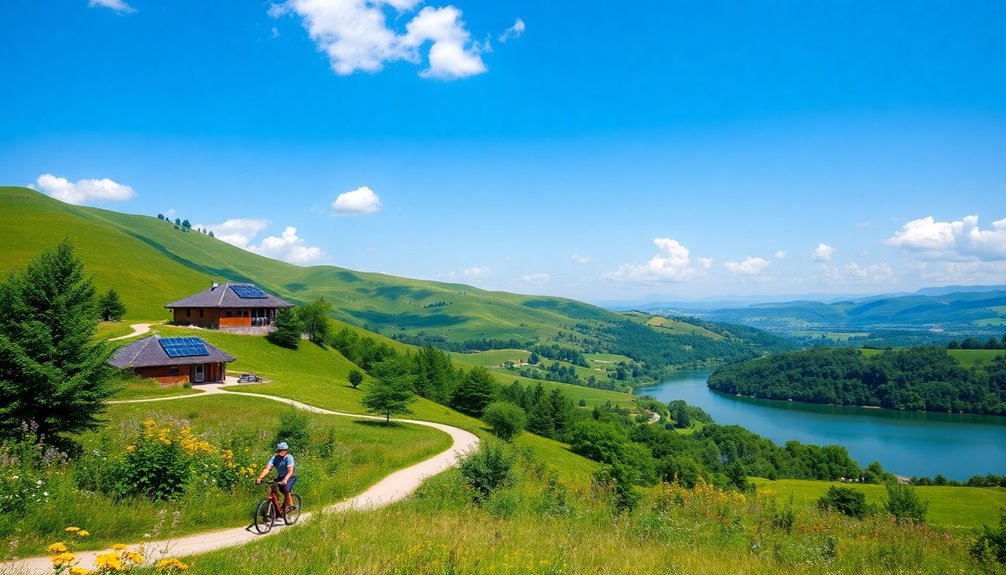
When planning your sustainable trip to Hungary, consider packing reusable travel containers to cut down on single-use plastics.
Also, familiarize yourself with responsible wildlife viewing guidelines to respect the local fauna and their habitats.
These small choices can make a big difference in protecting Hungary's natural beauty.
Reusable Travel Containers Essential
While exploring the beautiful landscapes of Hungary, you can make a significant impact on the environment by using reusable travel containers.
These eco-friendly options not only help reduce plastic waste but also support your budget. Here's why you should consider them:
- Cut down on plastic: Travelers contribute to 8 million tons of plastic waste annually; reusable containers can help decrease this.
- Save money: Refilling a water bottle in Budapest is cheaper than buying bottled water.
- Support sustainability: Using these containers aligns with Hungary's goal of a 50% emissions reduction by 2030.
Responsible Wildlife Viewing Guidelines
To ensure a sustainable experience while enjoying Hungary's rich wildlife, it's crucial to adhere to responsible viewing guidelines. Maintain a distance of at least 100 meters from animals to reduce stress and disturbance. Use designated trails and viewing platforms to protect sensitive ecosystems. Opt for guided eco-tours that promote responsible wildlife viewing and educate you about local biodiversity. Avoid feeding wildlife, as it can disrupt their natural behaviors. Also, choose eco-friendly accommodations and support local businesses dedicated to conservation.
| Action | Importance |
|---|---|
| Maintain distance | Minimizes stress to wildlife |
| Use designated trails | Protects fragile ecosystems |
| Choose guided eco-tours | Enhances understanding of wildlife |
| Avoid feeding wildlife | Preserves natural foraging behavior |
Frequently Asked Questions
Is Hungary a Sustainable Country?
You might find that Hungary faces significant challenges in sustainability.
With a low environmental sustainability score and high pollution levels, it's struggling to achieve its climate goals.
Biodiversity is under threat, ranking last among OECD countries in habitat conservation.
While the government has set ambitious targets for emissions reduction and climate neutrality, weak regulatory enforcement hampers progress.
Is Hungary in the Heart of Europe?
Yes, Hungary's often called the "Heart of Europe." If you look at its central location, it's bordered by seven countries, making it a key crossroads for cultures and trade.
You'll find that Budapest, the capital, exemplifies this blend of Eastern and Western influences. Its diverse landscapes, from plains to mountains, enhance its geographical significance.
What Are the Environmental Issues in Hungary?
When it comes to environmental issues in Hungary, you've got your work cut out for you. Air pollution is a major problem, with nitrogen dioxide levels often exceeding safe limits.
The country struggles with weak biodiversity regulations, ranking last among OECD nations. You'll notice a heavy reliance on fossil fuels, particularly Russian oil and gas, which complicates the shift to renewables.
Despite new measures like a CO2 tax, progress remains sluggish.
What Is the Main Ecosystem in Hungary?
You'll find that Hungary's main ecosystems include forests, wetlands, and grasslands.
Forests cover about 21% of the land, teeming with diverse flora and fauna.
Wetlands, especially the Ramsar sites, play a crucial role in supporting migratory birds and maintaining biodiversity.
Additionally, grasslands, like those in Hortobágy National Park, showcase the country's unique landscapes.
Each ecosystem contributes to Hungary's ecological richness, although they face significant threats that need urgent attention.
Conclusion
As you explore Hungary's green escapes, remember that every small choice you make can be a seed planted in the soil of sustainability. By supporting local businesses and engaging in community projects, you're not just a traveler; you're a vital part of a blossoming movement. Your journey can be a vibrant tapestry woven with care for the environment, ensuring that the beauty of Hungary thrives for generations to come. Embrace the adventure—nature's calling!

